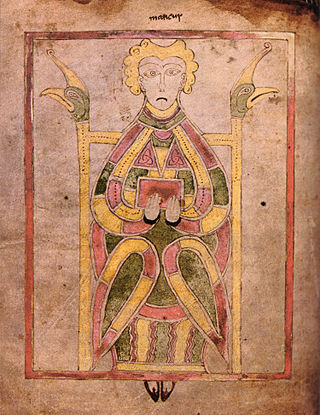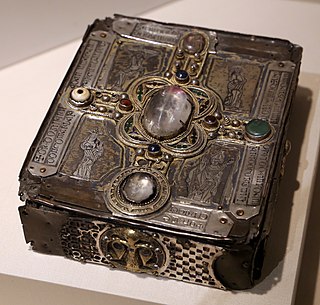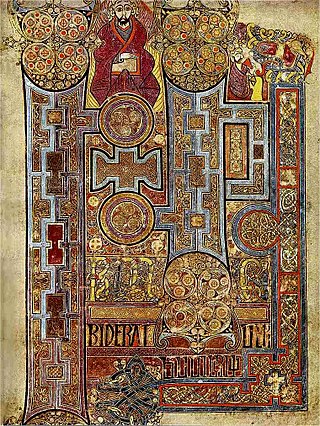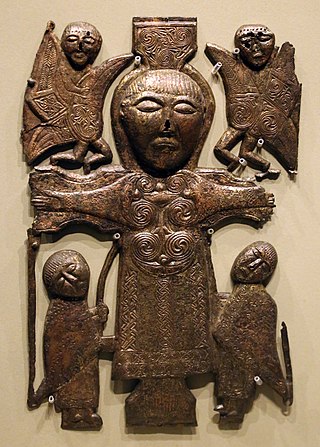Related Research Articles

The Book of Kells is an illuminated manuscript and Celtic Gospel book in Latin, containing the four Gospels of the New Testament together with various prefatory texts and tables. It was created in a Columban monastery in either Ireland or Scotland, and may have had contributions from various Columban institutions from each of these areas. It is believed to have been created c. 800 AD. The text of the Gospels is largely drawn from the Vulgate, although it also includes several passages drawn from the earlier versions of the Bible known as the Vetus Latina. It is regarded as a masterwork of Western calligraphy and the pinnacle of Insular illumination. The manuscript takes its name from the Abbey of Kells, County Meath, which was its home for centuries.

The Book of Durrow is an illuminated manuscript dated to c. 700 that consists of text from the four Gospels gospel books, written in an Irish adaption of Vulgate Latin, and illustrated in the Insular script style.

The Book of Dimma is an 8th-century Irish pocket Gospel Book originally from the Abbey of Roscrea, founded by St. Crónán in County Tipperary, Ireland. In addition to the Gospels of Luke and John, it has an order for the Unction and Communion of the Sick. The surviving illumination of the manuscript contains a number of illuminated initials, three Evangelist portrait pages, and one page with an Evangelist's symbol. The pocket gospel book is a distinctively Insular format, of which the Stowe Missal and Book of Mulling are other leading examples.

A cumdach or book shrine is an elaborate ornamented metal reliquary box or case used to hold Early Medieval Irish manuscripts or relics. They are typically later than the book they contain, often by several centuries. In most surviving examples the book comes from the peak age of Irish monasticism before 800, and the extant cumdachs date from after 1000, although it is clear the form dates from considerably earlier. The majority are of Irish origin, with most surviving examples now in the National Museum of Ireland (NMI).

A carpet page is a full page in an illuminated manuscript containing intricate, non-figurative, patterned designs. They are a characteristic feature of Insular manuscripts, and typically placed at the beginning of a Gospel Book. Carpet pages are characterised by mainly geometrical ornamentation which may include repeated animal forms. They are distinct from pages devoted to highly decorated historiated initials, though the style of decoration may be very similar.

Insular art, also known as Hiberno-Saxon art, was produced in the post-Roman era of Great Britain and Ireland. The term derives from insula, the Latin term for "island"; in this period Britain and Ireland shared a largely common style different from that of the rest of Europe. Art historians usually group Insular art as part of the Migration Period art movement as well as Early Medieval Western art, and it is the combination of these two traditions that gives the style its special character.

In the visual arts, interlace is a decorative element found in medieval art. In interlace, bands or portions of other motifs are looped, braided, and knotted in complex geometric patterns, often to fill a space. Interlacing is common in the Migration period art of Northern Europe, in the early medieval Insular art of Ireland and the British Isles, and Norse art of the Early Middle Ages, and in Islamic art.

The National Museum of Ireland – Archaeology is a branch of the National Museum of Ireland located on Kildare Street in Dublin, Ireland, that specialises in Irish and other antiquities dating from the Stone Age to the Late Middle Ages.

The Domnach Airgid is an 8th-century Irish wooden reliquary. It was considerably reworked between the 13th and 15th centuries and became a cumdach or "book shrine", when its basic timber structure was reinforced and decorated by elaborate silver-gilt metalwork. Its front-cover was enhanced by gilded relief showing Jesus in "Arma Christi", alongside depictions of saints, angels and clerics, in scenes imbued with complex iconography. It is thus considered a mixture of the early Insular and later International Gothic styles.

The Breac Maodhóg is a relatively large Irish house-shaped reliquary, today in the National Museum of Ireland. It is thought to date from the second half of the 11th century, and while periods as early as the 9th century have been proposed, the later dating is believed more likely based on the style of its decoration.

The Shrine of Miosach is an elaborately ornamented 11th-century Irish cumdach. It originates from Clonmany, north County Donegal, and is first mentioned in the 1165 Irish annals. It is dated to the late 11th century, when it probably contained a manuscript with psalms or extracts from a Gospel. However, the shrine was empty when first described in detail in the 18th century. It was originally associated with St Cairneach, patron saint of Dulane, County Meath, but by the late medieval period had become part of the cult of the abbot and missionary Colm Cille.

The Soiscél Molaisse is an Irish cumdach that originated from an 8th-century wooden core embellished in the 11th and 15th centuries with metal plates decorated in the Insular style. Until the late 18th century, the shrine held a now-lost companion text, presumed to be a small illuminated gospel book associated with Saint Laisrén mac Nad Froích, also known as Molaisse or "Mo Laisse". In the 6th century, Molaisse founded a church on Devenish Island in the southern part of Lough Erne in County Fermanagh, with which the cumdach is associated.

House-shaped shrine are early medieval portable metal reliquary formed in the shape of the roof of a rectangular building. They originate from both Ireland and Scotland and mostly date from the 8th or 9th centuries. Typical example consist of a wooden core covered with silver and copper alloy plates, and were built to hold relics of saints or martyrs from the early Church era; a number held corporeal remains when found in the modern period, presumably they were parts of the saint's body. Others, including the Breac Maodhóg, held manuscripts associated with the commemorated saint. Like many Insular shrines, they were heavily reworked and embellished in the centuries following their initial construction, often with metal adornments or figures influenced by Romanesque sculpture.

The Shrine of Saint Lachtin's Arm is an early 10th century Irish arm-shrine type reliquary made of wood and metal shaped as an outstretched forearm and clenched fist. St. Lachtin's dates to between 1118 and 1121 and is associated with his church in the village of Stuake, Donoughmore, County Cork, but probably originates from Kilnamartyra, also in Cork. It consists of a yew-wood core lined with decorated bronze and silver plates. The wood at the hand is hollowed out to create a reliquary cavity which once held the arm bone of St. Lachtin, but is now empty. The circular cap at its base contains a large transparent gemstone and is inlayed with silver decorated with filigree.
Griffin Murray is an Irish archaeologist and art historian specialising in medieval Ireland and Insular art–especially metalwork–in the period between 400–1550 AD. His interests include identifying and contextualizing the social role of medieval craftsmen, Viking art and the relations between insular and Scandinavian craftsmen, and he is a leading expert on both house-shaped shrines and insular croziers.

The Lismore Crozier is an Irish Insular-type crozier dated to between 1100 and 1113 AD. It consists of a wooden tubular staff lined with copper-alloy plates; embellished with silver, gold, niello and glass; and capped by a crook with a decorative openwork crest.

The Rinnegan Crucifixion Plaque is a late 7th or early 8th century Irish gilt-bronze crucifixion plaque sculpture found in the 19th century in the churchyard of St. John’s on the head of Lough Ree in Rinnegan County Westmeath, and near Athlone, County Roscommon. It is one of the earliest extant representations of the crucifixion in Irish art, and outside of illuminated manuscripts, a rare example of both representation and a narrative scene in early Irish Insular art.

Crucifixion plaques are small early medieval sculptures with a central panel of the still alive but crucified Jesus surrounded by four smaller ancillary panels. consisting. of Stephaton and Longinus in the lower quadrants, and two hovering attendant angels in the quadrants above his arms. Notable examples are found in classical Roman and 8th to mid-12th century Irish Insular art.

The Clonmacnoise Crucifixion Plaque is a late-10th or early-11th century Irish gilt-bronze sculpture showing the Crucifixion of Jesus, with two attendant angels hovering above his arms to his immediate left and right. Below them are representations of the Roman soldiers Stephaton and Longinus driving spears into his chest.
Cormac Bourke is an Irish archeologist specialising in Medieval studies, early church history and insular Christianity. He is a former, long term, curator of Medieval Antiquities at the Ulster Museum, Belfast, and currently works at the antiquities department of the National Museum of Ireland.
References
- 1 2 3 4 O'Rourke, Frances. "First encounters: Rachel Moss and Catherine Marshall". Irish Times , 23 November 2014. Retrieved 18 July 2021
- ↑ "Rachel Moss". Thames & Hudson. Retrieved 18 July 2021
- ↑ "TRINITY MONDAY 2022 - FELLOWS AND SCHOLARS". www.tcd.ie. Trinity College Dublin. 25 April 2022. Retrieved 26 April 2022.
- 1 2 "Dr. Rachel Moss, Associate Professor, History of Art". Trinity College Dublin. Retrieved 18 July 2021
- ↑ "Dr. Rachel Moss". Royal Society of Antiquaries of Ireland. Retrieved 18 July 2021
- 1 2 Harbison, Peter. "Art and architecture of Ireland". History Ireland , Issue 1, volume 23, January 2015. Retrieved 18 July 2021
- ↑ "Art and Architecture of Ireland: Volume I: Medieval". Royal Irish Academy. Retrieved 18 July 2021
- ↑ "Jason Ellis · Sculptor". jasonellis.ie. Retrieved 18 July 2021
- ↑ Review: "Art and Architecture of Ireland Volume I: Medieval c. 400–c. 1600". Royal Irish Academy, 2015, volume 1, p. 571
- ↑ Cosgrove, Peter. "Reviewed Work: Making and Meaning in INSULAR ART by Rachel Moss". Seanchas Ardmhacha: Journal of the Armagh Diocesan Historical Society, volume 22, No. 2, 2009. JSTOR 25747036
- ↑ Dr. Rachel Moss". Trinity College Dublin. Retrieved 18 July 2021
- ↑ Rachel Laura Moss. Google Scholar. Retrieved 18 July 2021